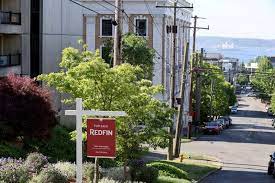(Reuters) – Sales of new U.S. single-family homes surged in July after three consecutive monthly declines, but real estate market momentum is slowing as rising home prices due to poor supply excludes some buyers for the first time from the market.
Although Tuesday’s Department of Commerce report showed a large surge in new housing stocks, the jump was driven by a record increase in homes yet to be built. Builders take longer to complete houses, limping from expensive raw materials as well as scarce land and workers.
“While demand for new homes remains strong, high prices and construction arrears will reduce sales in the coming months,” said Nancy Vanden Houten, a US economist at Oxford Economics in New York. “Homebuilders are reportedly driving away buyers in an effort to reduce the backlog of sales.”
New home sales increased 1.0% to a seasonally adjusted annual rate of 708,000 units last month. The June sales pace was revised up to 701,000 units from the previously reported 676,000 units.
Economists interviewed by Reuters had forecast new home sales, which account for 10.6% of US home sales, increasing at a rate of 700,000 units in July. Sales fell 27.2% year-on-year in July. The average price of new homes rose 18.4% from the previous year to a record $ 390,500 in July.
Sales jumped to a rate of 993,000 units in January, the highest since late 2006, driven by historically low mortgage rates and a desire for spacious housing as Americans worked from home and took online classes during the COVID-19 pandemic. .
The new home market is being driven by a severe shortage of previously owned homes. But builders have struggled to take full advantage of the tight supply, hampered by soaring timber prices and a shortage of other building materials and appliances.
Although timber prices have dropped sharply from May’s record highs, they remain above pre-pandemic levels. Reports this month showed that single-family building permits fell in July, while confidence among homebuilders hit a 13-month low in August.
A report on Monday showed that previously owned home sales rose modestly in July. to know more
Wall Street shares traded higher, with the S&P 500 (.SPX) and Nasdaq (.IXIC) indices reaching record highs, buoyed by oil and travel-related equities. The dollar (.DXY) remained flat against a basket of currencies. Prices of US Treasuries have mostly been lower.
Sales of new homes
STATES AT LOWEST COST
Last month’s increase in new home sales was driven by a 1.3% increase in the populous South and 14.4% in the West. Sales plunged 24.1% in the Northeast and fell 20.2% in the Midwest.
“The pandemic has accelerated migration to suburban markets and metropolitan areas in low-cost states like Arizona, Utah, Texas and Florida,” said Mark Vitner, senior economist at Wells Fargo in Charlotte, North Carolina. “Conversely, new home sales have weakened in areas where population growth has slowed, partly due to an outflow of residents seeking cheaper real estate, lower taxes and other lifestyle benefits.”
New home sales were concentrated in the $ 200,000 to $ 749,000 price range. Sales in the sub $ 200,000 price range, the sought-after market segment, accounted for only 1% of transactions.
“Affordability is becoming a growing problem in the new home market,” said Bernard Yaros, an economist at Moody’s Analytics in West Chester, Pennsylvania. “Single-family sales prices have risen 20% from their pre-pandemic level, which is slightly lower than the increase in sales prices in the existing home market, but is still enough to deter potential home buyers.”
There were 367,000 new homes on the market in July, the highest since November 2008 and up from 348,000 in June. The houses still to be built represented a record 28.6% of the supply. Completed houses made up only 9.8% of the supply.
At the July sales pace, it would take 6.2 months to release the supply of homes on the market, compared to 6.0 months in June. About 75% of the homes sold last month were under construction or still to be built.
“We expect sales to increase over the course of the year as there is sufficient demand, but the rate at which the acceleration occurs will likely be determined by how quickly homebuilders can clear their current arrears and overcome the material availability and other supply constraints, ”said Mark Palim, Fannie Mae’s deputy chief economist in Washington.
Reporting by Lucia Mutikani; Editing by Andrea Ricci and Paul Simao

